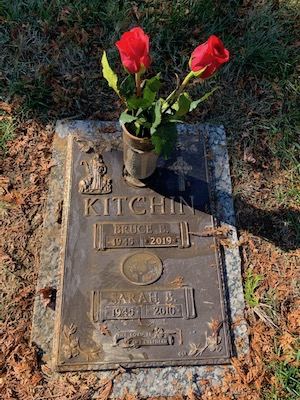Maintenance of the Dead

I let them bury my father in a sealer coffin. I knew how and why to say no. But I’d just won the battle not to embalm him and they recommended that, in that case, we should do a sealer coffin. No extra cost to the original. My best self would’ve argued. But I was not alone in that room, or alone with my sister—who trusts me on these things. I wasn’t even in the room. I was video conferencing from the phone screen of my dear aunt, who was grieving the loss of the big brother she called her “little brother.”
Because of my strained relationship with him and our knowledge he had a preplan (and would be with my mom, so I was willing to make a lot of concessions to how I might otherwise bury a family member) I hadn’t prepped with the family for any of this. And his estate was paying for the funeral. I knew he had the money to do so. It wasn’t worth the fight.
It still irritates me, though.
And as I prepare to go down to DC for Maintainers III this coming week, I have been reflecting on the maintenance of the dead.
Maintaining the Cemetery
My parents are buried in a concrete-lined vault, with a tombstone (probably actually called a memorial plaque or somesuch) that lies flat to the earth. The bronze plaque contains a vase which one can pull out, tip up, and use to hold flowers. It’s cunning. One brings flowers, waters them from a nearby spigot, and can leave them between mowings.
Before the cemetery mows, they send someone through to clean out all the flowers and objects, tip the vases back into the plaques, and leave a flattened landscape for the machine. The machine mows high enough not to score the plaques. And the cycle continues.
The concrete sides mean their caskets won’t slip into their neighbor’s plot if there’s a rainstorm. The concrete top means the grass stays flat. Is there a concrete bottom? I hope not. But I don’t know. When my mother was buried, I was too devastated to ask. I didn’t have the language and was still a few months away from my journey to learn more about death and burial. When my father was buried, I was too exhausted. And it was pointless, since everything was in place.
The arrangement’s neat. They’re shelved like a couple of Hollinger boxes, in case anyone needs to find them. There is a strange comfort in knowing that they’re filed together. It’s 10am on a Saturday morning and I know exactly where my parents are and what they’re doing. Or at least where my parents’ bodies are. Shit, they’re probably right behind me. Cue the October jump scare.
Everything about this cemetery is build for order, efficiency, and convenient maintenance. It’s ordered. Neat. Tidy. Only scary in the ways that vast lawns and nothingness are scary.
Maintaining the Body
The sealer casket is and isn’t part of this. It doesn’t functionally contribute to that tidy order which makes for convenient cemetery maintenance. It’s just part of the atmosphere. I’m not gonna explain exactly what it is, for that you’ll want to watch the video linked in the first paragraph.
It’s not like it would be holding his body the whole time until the funeral (4 days from the conversation). During that period, he’d be in a cool space. Morgue. Fridge. So it’s not like he needs the seal because he’s not being embalmed and there was a risk of… odors.
And then, once the funeral’s over? He’s in the ground. It would be a lot of time, money, headache, and paperwork to get him back out. When someone’s buried, the family tends to fight particularly hard to keep them that way.
Or, as Caitlin asks in the video above: “Even if the sealer casket did work perfectly, to what end are you paying for this? Are you planning to occasionally exhume mom…?”
I went to see her on her book tour on my birthday, which was also the 6-month anniversary of burying my father. I wish I’d thought at the time to do an audience question: “I buried my dad, unembalmed, in a sealer casket exactly 6 months ago. What state would he be in today?”
Embalmed bodies like my mom’s (I had no hand in her arrangements) decay a bit slower, but big picture? They’re both decomposing down there. I assume his got started right away. Seal or no seal, the decomposition comes from inside the body. Concrete or no concrete, the world will get things done. Water will chip away at the cement. Bugs will get in. If they don’t? Bacteria can still make it happen. THIS IS WHAT DEAD BODIES ARE SUPPOSED TO DO.
After the funeral, I’m not sure what we’re supposed to want from these body maintaining techniques from embalming, which isn’t legally required and not necessary for many funerals, to sealer caskets. Do we want to encounter them again as some kind of dried husk? As a colleague said recently “I was raised Catholic, if they’re not gonna corrupt, they’re just not gonna corrupt.” Otherwise, I don’t understand the end game.
Maintaining a thing must be maintaining it for some reason or purpose. Your loved ones are already pressured to be maintaining their looks, their weights, their flexibility, their lifestyle… when you’ve said goodbye, don’t push their bodies into maintaining one more idealized form. Allow them to go the way of all flesh with less of a fight.
Having written this, I’m now thinking about cemeteries I saw in Romania and things I learned. Perhaps I’ll write about that and share some pictures. Photograph of my parents’ grave is by my aunt.